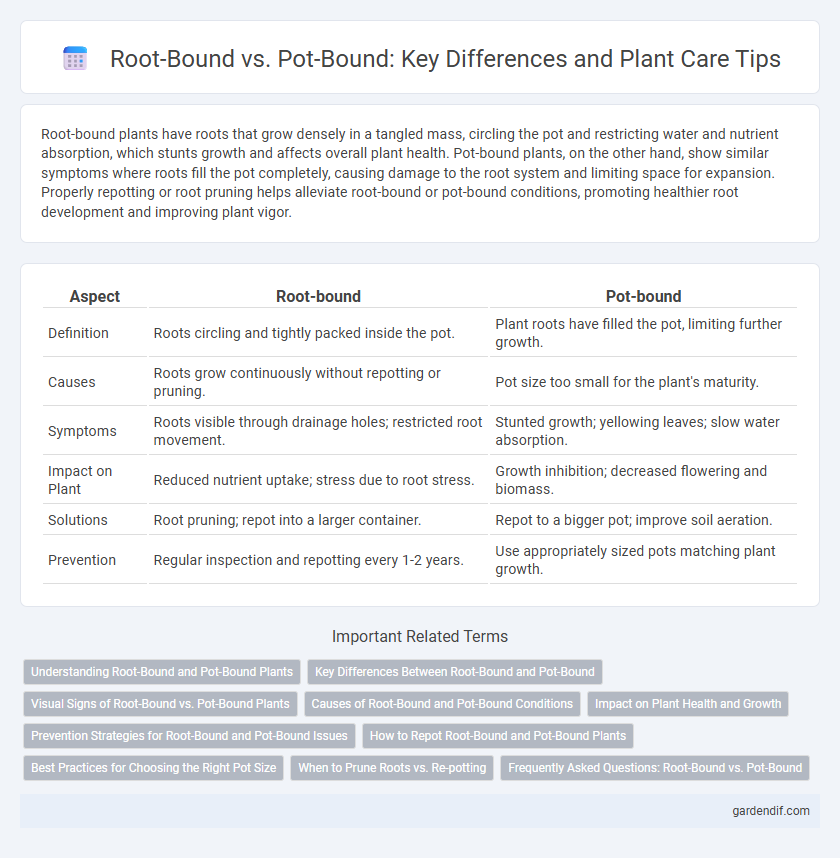
Root-bound vs Pot-bound Illustration
Root-bound plants have roots that grow densely in a tangled mass, circling the pot and restricting water and nutrient absorption, which stunts growth and affects overall plant health. Pot-bound plants, on the other hand, show similar symptoms where roots fill the pot completely, causing damage to the root system and limiting space for expansion. Properly repotting or root pruning helps alleviate root-bound or pot-bound conditions, promoting healthier root development and improving plant vigor.
Table of Comparison
| Aspect | Root-bound | Pot-bound |
|---|---|---|
| Definition | Roots circling and tightly packed inside the pot. | Plant roots have filled the pot, limiting further growth. |
| Causes | Roots grow continuously without repotting or pruning. | Pot size too small for the plant's maturity. |
| Symptoms | Roots visible through drainage holes; restricted root movement. | Stunted growth; yellowing leaves; slow water absorption. |
| Impact on Plant | Reduced nutrient uptake; stress due to root stress. | Growth inhibition; decreased flowering and biomass. |
| Solutions | Root pruning; repot into a larger container. | Repot to a bigger pot; improve soil aeration. |
| Prevention | Regular inspection and repotting every 1-2 years. | Use appropriately sized pots matching plant growth. |
Understanding Root-Bound and Pot-Bound Plants
Root-bound plants have roots tightly encircling the pot's interior, restricting water and nutrient absorption, while pot-bound describes a plant confined within a small container limiting growth potential. Both conditions stress the root system, causing slowed growth, yellowing leaves, and reduced overall plant health. Regularly checking root development and repotting into larger containers prevents root-bound and pot-bound issues, promoting optimal plant vitality.
Key Differences Between Root-Bound and Pot-Bound
Root-bound plants have roots that densely circle the inside of the pot, often creating a tight, compact mass that restricts nutrient and water absorption. Pot-bound refers to a plant whose growth is limited by the size of the container, leading to stunted growth and poor overall health due to insufficient root space. Understanding the difference is crucial for proper repotting and ensuring optimal plant development and vitality.
Visual Signs of Root-Bound vs. Pot-Bound Plants
Root-bound plants display dense, circling roots tightly packed against the pot edges, often causing root distortion and limited soil visibility. Pot-bound plants exhibit similar symptoms but may show more advanced signs such as root ball shrinking and soil drying out quickly due to restricted root expansion. Visual indicators like pot deformation, stunted growth, and poor drainage are common in both conditions, signaling an urgent need for repotting.
Causes of Root-Bound and Pot-Bound Conditions
Root-bound conditions occur when a plant's roots outgrow the container, circling tightly and limiting nutrient and water absorption due to restricted space. Pot-bound arises from prolonged confinement in a pot too small for the root system, causing roots to thrash and become densely packed, which impairs growth and plant health. Both conditions are primarily caused by inadequate pot size and lack of regular repotting to accommodate root expansion.
Impact on Plant Health and Growth
Root-bound plants experience restricted root growth due to overcrowded roots in the pot, leading to reduced nutrient uptake and stunted development. Pot-bound conditions cause soil to dry out quickly and limit water absorption, stressing the plant and hindering photosynthesis. Both scenarios reduce overall plant vigor, increase susceptibility to diseases, and require timely repotting to restore optimal root function and growth.
Prevention Strategies for Root-Bound and Pot-Bound Issues
Ensuring proper prevention of root-bound and pot-bound issues involves selecting appropriately sized pots that accommodate expected root growth and using high-quality, well-draining soil to promote healthy root expansion. Regularly monitoring root health by inspecting plants during repotting intervals of 12 to 18 months helps avoid constricted root systems that stunt growth. Incorporating slow-release fertilizers and maintaining consistent watering schedules support robust root development and reduce the risk of plants becoming root-bound or pot-bound.
How to Repot Root-Bound and Pot-Bound Plants
Repotting root-bound and pot-bound plants requires carefully loosening the tangled roots to encourage healthy growth. Trim any excessively long or circling roots with sterilized scissors before placing the plant in a larger pot filled with fresh, nutrient-rich soil. Water thoroughly after repotting to help the plant recover and establish itself in its new environment.
Best Practices for Choosing the Right Pot Size
Root-bound plants exhibit tightly tangled roots circling the pot's interior, restricting nutrient absorption and growth, while pot-bound plants experience similar stress due to inadequate space. Selecting the right pot size involves choosing one 1-2 inches larger in diameter than the current root ball to ensure healthy root expansion without causing water retention issues. Using pots with proper drainage holes and breathable materials like terracotta further promotes optimal root health and prevents root rot in container gardening.
When to Prune Roots vs. Re-potting
Root-bound plants develop dense, circling roots that restrict growth, signaling the need for re-potting to provide more space and fresh soil nutrients. Pot-bound conditions occur when roots tightly fill the container, often causing poor drainage and nutrient deficiencies, which can be alleviated by trimming excessively long or damaged roots before re-potting. Timely root pruning helps stimulate healthy root growth while preventing root rot, making re-potting essential when roots spiral heavily or soil quality declines.
Frequently Asked Questions: Root-Bound vs. Pot-Bound
Root-bound plants have dense, circling roots tightly packed inside the container, restricting growth and nutrient absorption, while pot-bound refers more broadly to plants constrained by their container size, leading to stunted development. Common signs of root-bound plants include roots emerging from drainage holes and slowed growth, whereas pot-bound symptoms might also involve overall plant stress due to limited soil volume. Effective management requires repotting into larger containers with fresh soil to promote healthy root expansion and improve plant vitality.
Root-bound vs Pot-bound Infographic

 gardendif.com
gardendif.com